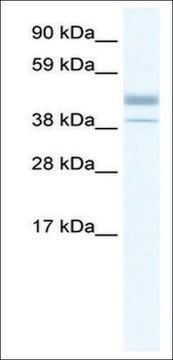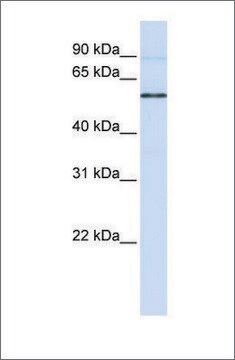おすすめの製品
由来生物
rabbit
品質水準
結合体
unconjugated
抗体製品の状態
affinity isolated antibody
抗体製品タイプ
primary antibodies
クローン
polyclonal
形状
buffered aqueous solution
化学種の反応性
human
テクニック
immunohistochemistry (formalin-fixed, paraffin-embedded sections): 1 μg/mL using human liver, hepatocytes
UniProtアクセッション番号
輸送温度
dry ice
保管温度
−20°C
遺伝子情報
human ... ESRRB(2103)
mouse ... Esrrb(26380)
rat ... Esrrb(299210)
免疫原
synthetic peptide corresponding to the internal domain of human estrogen-related receptor β, conjugated to KLH. The immunizing peptide has 93% homology with the rat and mouse gene.
アプリケーション
Anti-Estrogen-Related Receptor β antibody produced in rabbit was used for immunocytochemistry of neurons from mouse model of glaucoma at a working dilution of 1:500. It was also used for immunohistochemistry of mouse brain sections.
生物化学的/生理学的作用
Estrogen-Related Receptors (ERR) are hormone receptors that bind estrogen response elements that in turn bind specific DNA sequences and regulate transcription. Three ERRs are known, alpha, beta and gamma, with highly conserved ligand and DNA binding sequences. ERRβ is selectively expressed in brain and is an important modulator of energy balance, food intake, neuropeptide levels and response to stress.
物理的形状
Solution in phosphate buffered saline, containing 0.1% sodium azide.
免責事項
Unless otherwise stated in our catalog or other company documentation accompanying the product(s), our products are intended for research use only and are not to be used for any other purpose, which includes but is not limited to, unauthorized commercial uses, in vitro diagnostic uses, ex vivo or in vivo therapeutic uses or any type of consumption or application to humans or animals.
適切な製品が見つかりませんか。
製品選択ツール.をお試しください
保管分類コード
10 - Combustible liquids
WGK
nwg
引火点(°F)
Not applicable
引火点(℃)
Not applicable
適用法令
試験研究用途を考慮した関連法令を主に挙げております。化学物質以外については、一部の情報のみ提供しています。 製品を安全かつ合法的に使用することは、使用者の義務です。最新情報により修正される場合があります。WEBの反映には時間を要することがあるため、適宜SDSをご参照ください。
Jan Code
E0156-BULK:
E0156-50UL:
E0156-50UL-PW:
E0156-VAR:
試験成績書(COA)
製品のロット番号・バッチ番号を入力して、試験成績書(COA) を検索できます。ロット番号・バッチ番号は、製品ラベルに「Lot」または「Batch」に続いて記載されています。
María Angeles Real et al.
Neuroscience letters, 438(1), 48-53 (2008-05-13)
Recently, a new nuclear receptor subfamily has been identified and referred to as estrogen-related receptors. This new group shares sequence similarity, target genes, co-regulatory proteins, and action sites with the estrogen receptors; however, natural estrogens are not estrogen-related receptors ligands.
Silmara de Lima et al.
Proceedings of the National Academy of Sciences of the United States of America, 109(23), 9149-9154 (2012-05-23)
The mature optic nerve cannot regenerate when injured, leaving victims of traumatic nerve damage or diseases such as glaucoma with irreversible visual losses. Recent studies have identified ways to stimulate retinal ganglion cells to regenerate axons part-way through the optic
S D Crish et al.
Neuroscience, 229, 55-70 (2012-11-20)
Failure of anterograde transport to distal targets in the brain is a common feature of neurodegenerative diseases. We have demonstrated in rodent models of glaucoma, the most common optic neuropathy, early loss of anterograde transport along the retinal ganglion cell
Lauren K Wareham et al.
iScience, 24(10), 103141-103141 (2021-10-15)
The interleukin-6 (IL-6) family of cytokines and its downstream effector, STAT3, are important mediators of neuronal health, repair, and disease throughout the CNS, including the visual system. Here, we elucidate a transcription-independent mechanism for the neuropoietic activities of IL-6 related
Francisco M Nadal-Nicolás et al.
Zoological research, 44(1), 226-248 (2023-01-04)
Univocal identification of retinal ganglion cells (RGCs) is an essential prerequisite for studying their degeneration and neuroprotection. Before the advent of phenotypic markers, RGCs were normally identified using retrograde tracing of retinorecipient areas. This is an invasive technique, and its
ライフサイエンス、有機合成、材料科学、クロマトグラフィー、分析など、あらゆる分野の研究に経験のあるメンバーがおります。.
製品に関するお問い合わせはこちら(テクニカルサービス)






